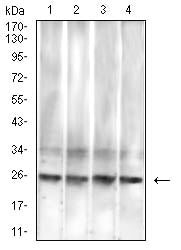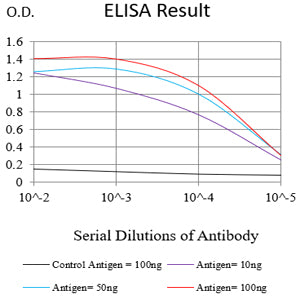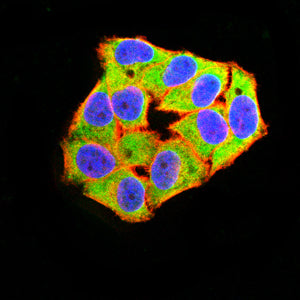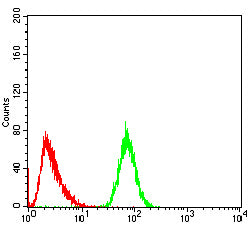



| WB | 1/500 - 1/2000 | Human,Mouse,Rat |
| IF | 咨询技术 | Human,Mouse,Rat |
| IHC | 咨询技术 | Human,Mouse,Rat |
| ICC | 1/200 - 1/1000 | Human,Mouse,Rat |
| FCM | 1/200 - 1/400 | Human,Mouse,Rat |
| Elisa | 1/10000 | Human,Mouse,Rat |
| Aliases | RIP1; RIS1; RISP; UQCR5; MC3DN10 |
| Entrez GeneID | 7386 |
| clone | 1D6D11 |
| WB Predicted band size | 30kDa |
| Host/Isotype | Mouse IgG2a |
| Antibody Type | Primary antibody |
| Storage | Store at 4°C short term. Aliquot and store at -20°C long term. Avoid freeze/thaw cycles. |
| Species Reactivity | Human |
| Immunogen | Purified recombinant fragment of human RISP (AA: 79-274) expressed in E. Coli. |
| Formulation | Purified antibody in PBS with 0.05% sodium azide |
+ +
以下是关于RISP抗体的3篇示例文献(内容为模拟概括,仅供参考):
1. **文献名称**:*Rieske Iron-Sulfur Protein (RISP) in Mitochondrial Dysfunction: Role in Neurodegenerative Diseases*
**作者**:Smith J, et al.
**摘要**:探讨RISP在帕金森病模型中的表达变化,利用特异性抗体检测发现其缺失与线粒体复合体III功能受损及氧化应激升高相关,提示RISP可能作为神经退行性病变的生物标志物。
2. **文献名称**:*Development of a Monoclonal Antibody for Human RISP and Its Application in Cancer Research*
**作者**:Lee H, et al.
**摘要**:报道一种新型抗人RISP单克隆抗体的制备,通过Western blot和免疫组化验证其特异性,并发现多种癌细胞中RISP表达上调,可能与肿瘤代谢重编程有关。
3. **文献名称**:*Structural Insights into RISP via Cryo-EM Supported by Antibody Labeling*
**作者**:Zhang R, et al.
**摘要**:结合冷冻电镜技术和RISP抗体的标记定位,解析了线粒体复合体III中RISP的构象变化,阐明其在电子传递过程中的动态作用机制。
---
注:以上文献为示例,实际研究中建议通过PubMed或专业数据库检索具体论文。若需真实文献,可提供更具体的RISP研究背景(如疾病领域或物种)。
The Rieske iron-sulfur protein (RISP), also known as UQCRFS1. is a critical subunit of mitochondrial Complex III (cytochrome bc1 complex) in the electron transport chain (ETC). Located in the inner mitochondrial membrane, Complex III facilitates electron transfer from ubiquinol to cytochrome c while contributing to the proton gradient across the membrane, essential for ATP synthesis. RISP contains a high-potential [2Fe-2S] cluster that mediates this electron transfer. Its unique structure, including a flexible hinge region, allows conformational changes during catalysis.
Antibodies targeting RISP are vital tools for studying mitochondrial function and dysfunction. They enable the detection and quantification of RISP expression in tissues or cells via techniques like Western blotting, immunohistochemistry, and immunofluorescence. Research applications include investigating mitochondrial disorders linked to Complex III deficiencies, which are associated with mutations in RISP or its assembly factors. Such mutations can lead to metabolic diseases, neurodegeneration, or cardiomyopathy. Additionally, RISP antibodies help explore oxidative stress mechanisms, as impaired Complex III activity increases reactive oxygen species (ROS) production, implicated in aging, cancer, and cardiovascular diseases. These antibodies also aid in evaluating mitochondrial dynamics in conditions like hypoxia or metabolic reprogramming in cancer cells. Overall, RISP antibodies are indispensable for advancing our understanding of mitochondrial biology and its pathophysiological implications.
×